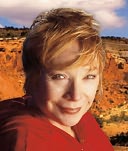- Shopping Bag ( 0 items )
From Barnes & Noble
The Barnes & Noble ReviewOn the path of The Camino, Shirley MacLaine wanders through puzzling visions. Often, these visions seem to her too strange to share; at one point, she wonders: "Could I ever tell my dream visions to anyone without seeing his eyes roll? It took an act of control not to roll my eyes at myself!" MacLaine is right to worry about revealing her premonitions. Skeptics too easily dismiss spiritual groping as vague-headed silliness, while they joke about subjects they cannot fathom. Despite the danger, however, MacLaine boldly records her spiritual wanderings in The Camino. In it, as in each of her bestselling memoirs, MacLaine relates her experiences in simple, forthright terms. She braves the critics and their eye-rolling to allow us a share in her spiritual struggles.
MacLaine's many books have chronicled her life's metaphysical stretches: In Out on a Limb, for example, she surprised readers by revealing her faith in past lives. In each of her revelations, MacLaine explores the connections between her public and private worlds. For MacLaine, the spiritual realm is connected to physical matter -- and she willingly traverses the paths that connect them. In The Camino, she describes her thoughts and adventures along the Camino trail, a 500-mile pilgrimage that begins in France and cuts through northern Spain to the cathedral of Santiago de Compostela. The Camino presents a physical challenge, even for a lifelong dancer like MacLaine: It is filthy, dangerous, and tiring. MacLaine walks it alone, beset by dogs, deceptive tourists, and the violent taunting of the press. She wears blisters into her heels; she carves ten pounds off her lean dancer's frame; she walks miserably through walls of bees. The Camino, as an exercise, pushes MacLaine to her physical limits.
But the hike also pushes MacLaine spiritually. Throughout the brutal trek, MacLaine confronts a series of visions in which she begins to investigate both her solitude and her personal relationships. In many of MacLaine's visions -- or memories -- she sees herself in another life, as a Moorish girl who had once ridden across the Camino. In this persona, MacLaine listens to a monk named John the Scot, who describes the healing possibilities of the pilgrim's trail. She explains: "He said the Camino accentuated feelings of unresolved issues&.the dreams and visions of people walking the trail created footmarks of past truth, which created reminiscences, which were part of the human subconscious lurking within each of us as foreshadowings." MacLaine and her ghostly mentor hint, that is, that visions can help each person understand her past distress. And by understanding this distress, somehow she can make room for a pleasure that can ease life and death. MacLaine and John write: "The joy comes when the cup of sorrow is emptied. Therefore, the joys and the sorrows along the Camino are the rediscovery of your own soul."
MacLaine's journey moves her through episodes in her Moorish life, where she finds herself accepting Christianity along with her own magical powers of healing. This inner journey culminates with a prolonged vision of the beginnings of the world, in which MacLaine explores her desire to be alone and her powerful need for human connection. In this final vision, MacLaine sees herself in another era of human evolution, in which androgynous persons become sexed in order to approach God in their reconnection. She dreams of civilizations in which total connection is possible and then reawakens to her own solitude on the trail.
For MacLaine, these visions need not be material to be meaningful; they need only encourage moral growth. She shrugs: "The Camino&seemed to be a walking meditation on what I had learned internally&.If the Garden of Eden had indeed been lost, I would seek to find it again. If other terrestrial species had sought to achieve that balance themselves, then I would give more attention to UFO sightings and why they were here&. And if we had once been androgynous, then I would cease to stereotype any person's sexual orientation or preference. If the Camino's energy had amplified all those memories for me, then I would trust it." Most importantly, then, MacLaine's imagined worlds (or memories) guide her to explore her beliefs more deeply and to speak about them more honestly.
In this latest chronicle of discovery, MacLaine bravely and openly explores her own imagination, memories, and heart. In doing so, she pushes her readers to think more freely about their own spiritual journeys. MacLaine's progress encourages us to connect dreams with physical life, to develop our bodies morally. The journey is incredible. (Jesse Gale)





Overview
It has been nearly three decades since Shirley MacLaine commenced her brave and public commitment to chronicling her personal quest for spiritual understanding. In testament to the endurance and vitality of her message, each of her eight legendary bestsellers — from Don't Fall Off the Mountain to My Lucky Stars — continues today to attract, dazzle, and transform countless new readers. Now Shirley is back — with her most breathtakingly powerful and unique book yet.
This is the ...